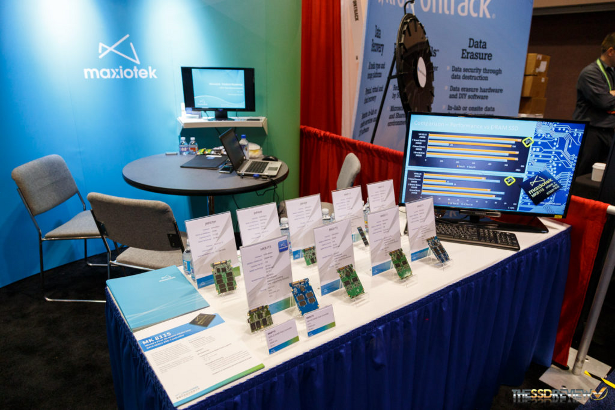Back in August of this year our Sean Webster was at Flash Memory Summit 2016, and had the opportunity to visit the Maxiotek display (view our coverage here). On display was their new MK8115 DRAM-less SSD controller that supports 3D MLC and 3D TLC NAND. The new Maxiotek controller has reportedly been widely adopted by numerous major SSD brands, resulting in Maxiotek announcing that they have begun mass production.
 Maxiotek’s MK8115 is the first DRAM-less SSD controller that supports 3D NAND, and is designed for the fast-growing market segment that prefers performance and reliability as major features. Maxiotek’s proprietary controller architecture is combined with intelligent firmware features, such as AgileECC, WriteBooster, Virtual Parity Recovery, and more. These features allow the MK8115 to achieve performance that is on par with DRAM-class SSDs for typical workloads.
Maxiotek’s MK8115 is the first DRAM-less SSD controller that supports 3D NAND, and is designed for the fast-growing market segment that prefers performance and reliability as major features. Maxiotek’s proprietary controller architecture is combined with intelligent firmware features, such as AgileECC, WriteBooster, Virtual Parity Recovery, and more. These features allow the MK8115 to achieve performance that is on par with DRAM-class SSDs for typical workloads.
 According to Maxiotek CEO Henry Chao, “The SSD products using the MK8115 will soon be available in the market.” The company further stated that “The controller provides customers cost-effective solutions for their next-generation SSDs by expanding the capacity up to 1TB, accelerating access performance, as well as improving reliability. The MK8115 is your ideal SSD controller option to the 3D-NAND era.”
According to Maxiotek CEO Henry Chao, “The SSD products using the MK8115 will soon be available in the market.” The company further stated that “The controller provides customers cost-effective solutions for their next-generation SSDs by expanding the capacity up to 1TB, accelerating access performance, as well as improving reliability. The MK8115 is your ideal SSD controller option to the 3D-NAND era.”
 3D-NAND has proven to be a revolutionary technology as compared to 2D (planar) NAND, with improved reliability and endurance, as well as higher density. This has accelerated the reduction of NAND costs per GB of storage capacity. MK8115 utilizes dual processors to create satisfactory data transmission rates with the latest NAND flash memory, including 3D-MLC and 3D-TLC NAND. MK8115 supports NAND flash memory of SLC 2x and MLC 1x/1y/1z/3D as well.
3D-NAND has proven to be a revolutionary technology as compared to 2D (planar) NAND, with improved reliability and endurance, as well as higher density. This has accelerated the reduction of NAND costs per GB of storage capacity. MK8115 utilizes dual processors to create satisfactory data transmission rates with the latest NAND flash memory, including 3D-MLC and 3D-TLC NAND. MK8115 supports NAND flash memory of SLC 2x and MLC 1x/1y/1z/3D as well.
 MK8115’s DRAM-less design opens up PCB design for SSDs as the area required for DRAM chips can now be populated with additional NAND instead. 3D NAND allows for the creation of M.2 SSDs with up to 1TB of capacity with all of the NAND flash chips on a single side of the PCB. This should result in some very creative small form factor designs for a variety of usage scenarios.
MK8115’s DRAM-less design opens up PCB design for SSDs as the area required for DRAM chips can now be populated with additional NAND instead. 3D NAND allows for the creation of M.2 SSDs with up to 1TB of capacity with all of the NAND flash chips on a single side of the PCB. This should result in some very creative small form factor designs for a variety of usage scenarios.
 Key features of the MK8115 include:
Key features of the MK8115 include:
- Sequential read speeds of up to 560 MB/s
- Sequential write speeds of up to 525 MB/s
- Random read speeds of up to 90,000 IOPS
- Random write speeds of up to 75,000 IOPS
- Agile ECC that provides best-in-class flexible flash protection with well- balanced reliability and throughput. Supports Maxiotek’s hardware-based RAID engine VPR (Virtual Parity Recovery)
- WriteBooster significantly enhances data transmission rates and sustained performance with 3D-TLC NAND.
- Support for SLC 2x, MLC 1x/1y/1z/3D and TLC 3D NAND
- Supports hardware-based AES-256 encryption
- Supports TCG-OPAL 2.0 compliant and SED (Self-Encrypted-Drive) versions that allow it to comply with various standards
 Maxiotek, utilizing their advanced technology, experienced engineering team, wealth of data storage know-how, and close relationships with key partners have positioned themselves to be a key player in the ever-growing 3D NAND SSD market. For more information, visit www.maxiotek.com.
Maxiotek, utilizing their advanced technology, experienced engineering team, wealth of data storage know-how, and close relationships with key partners have positioned themselves to be a key player in the ever-growing 3D NAND SSD market. For more information, visit www.maxiotek.com.
 The SSD Review The Worlds Dedicated SSD Education and Review Resource |
The SSD Review The Worlds Dedicated SSD Education and Review Resource | 
1 TB on m2 ok but 500/500 R/W too ? Sad. I hope this will allow for some more power on both sided m2 and I hope it does evolve fast.
I’d say sequential performance is the least important for the consumers. It’s the random performance and consistency that matters. What good is 500MB/s+, if speeds drop to near zero once you start pushing random writes for example.